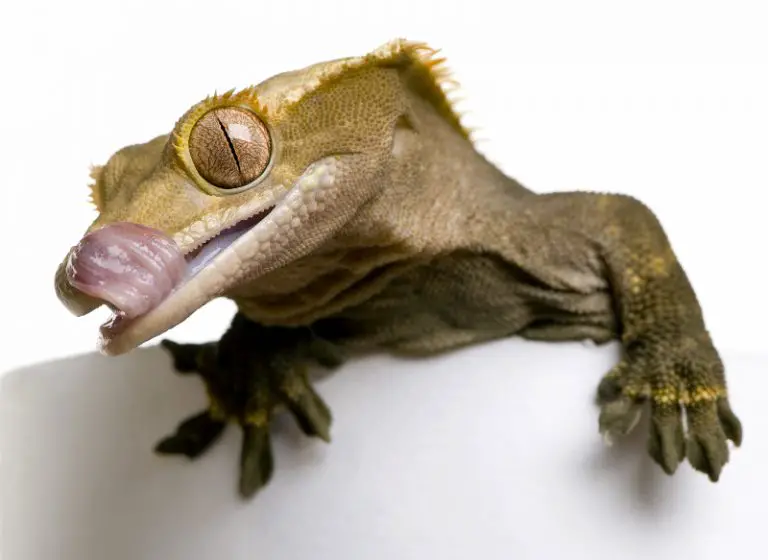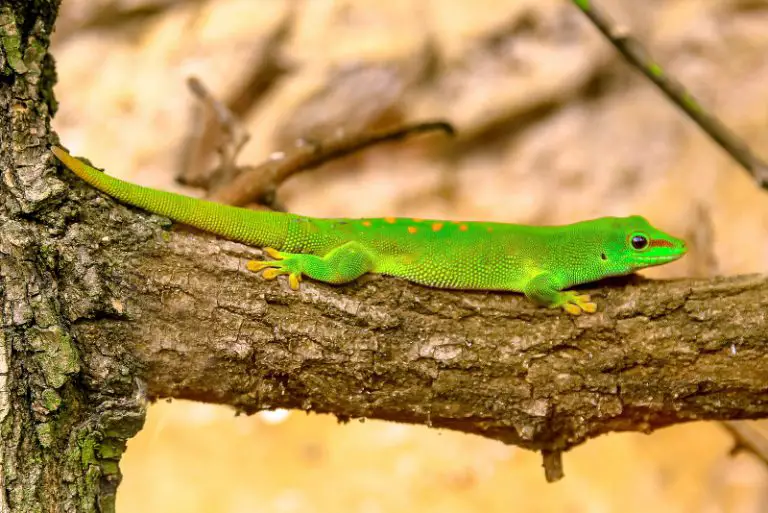Can Leopard Geckos Swim? [Must Read]

Many people who own lizards put larger water dishes into their enclosures. This gives the lizard space to soak and swim; a good way to exercise. You may have heard this is a good idea, and were thinking of putting in a pool for your leopard gecko.

Not all lizards are the same though, and not all lizards like to swim. What about leopard geckos? Can leopard geckos swim?
In this article, I cover whether leopard geckos can swim, reasons why they shouldn’t, whether leopard geckos can drown, whether they need water and whether you should bath your leopard gecko. Let’s start!
Contents
Table of Contents
What Are Leopard Geckos?
Leopard geckos are found naturally in warm, arid environments. They are found in countries like Afghanistan, Iran, Pakistan, and northern parts of India.
They lack the adhesive lamella found on some other lizards. These are the things that lizards use to climb up surfaces. Because of this, leopard geckos are not good climbers. However, they do have small claws that help them to easily run through sand.
These are one of the most popular types of geckos kept as pets, although they can be trickier to care for. Unlike other geckos who have a varied diet, leopard geckos are strictly insectivores. This makes your job more difficult because insects can be a pain to take care of.
Still, these critters are fun to care for, and are pretty to look at. They are generally a light yellow or cream color with dark spots down their body. The coloring looks nice, and it helps them stay camouflaged in desert environments.
Can Leopard Geckos Swim?
Do leopard geckos like to swim? They don’t, but can a leopard gecko swim? They can’t really swim. Instead, they float. If they try to swim, it is sloppy and awkward. Being in deep water simply stresses them out, and it is possible for them to drown.
Not only can they drown, but being in deep water for too long can cause health complications. We’ll go over those further.
Why Shouldn’t Leopard Geckos Swim?
It Can Make Them Sick
In the wild, leopard geckos live in warm, arid places. They avoid water whenever they can and will hide from rain. They will come out for a bit to drink up fresh rainfall, but they will quickly go back into hiding.
This is because water plays a big part in regulating body temperature. Leopard geckos need to stay hydrated to regulate their temperature. Still, too much water can make them sick.
Water will automatically make a gecko’s body temperature cool down. This can be good when they need to cool down. But, if their body temperatures drop too low, it can cause problems.
To get their body temperatures back to normal, they will move toward their hot basking space. This causes an extreme shift in body temperature in a short span of time.
If this happens occasionally, it’s not usually a big deal. However, if it happens frequently, it can make your lizard quite sick. It will lower their immunity levels, making it more likely for them to get sick. It can also cause respiratory infections. In young lizards, it may even stunt their growth.
Respiratory Problems
Geckos are similar to humans in the way they breathe. They have lungs just like us, and they can only hold their breath for about a minute.
Also like us, they are likely to become sick when repeatedly exposed to varying temperatures. It is very easy for leopard geckos to develop respiratory infections.
Immune System Problems
As we stated, drastic changes in temperature can cause immune problems. Besides stunting growth, it can also cause secondary infections. Fungal, bacterial, or viral infections are common.
Stress
As we stated before, deep water will easily stress your gecko out. This can lead to them drowning as they fight to flee the water. It may also cause them to drop their tails.
If the stress becomes too extreme, they may stop eating or may hide for long periods of time. Some may even refuse to drink water because they have developed such a bad fear of it.
Tankmates
Some reptile owners like to keep multiple species together. This can sometimes go well, especially if they’re not invading each other’s spaces.
Some people choose to make half their terrarium water based. The other half is terrestrial or arboreal based.
Unfortunately, this isn’t a good idea for owners of leopard geckos. Some people do have these set-ups and have reported no problems. They say their gecko will enter the water of its own free will to soak, and will leave when it’s ready.
Although this may work for some people, it’s better not to risk it. Just because something hasn’t happened doesn’t mean it can’t or won’t happen. It’s always better to use caution and prevent anything bad from happening.
For example, if your leopard gecko accidentally falls into the water, they may panic. Thrashing around because of panic will make them lose energy more quickly. It will also make it more difficult for them to float and get to safety. In these situations, drowning can happen very quickly.
Watch this video:
Can A Leopard Gecko Drown?
Unfortunately, deep water just isn’t good for leopard geckos.. Although they can float, they can’t swim well. Being in deep water for too long will stress them out and make them sick.
Worst of all, it can cause them to drown.
If you see a leopard gecko trying to swim, it will be awkward and messy. They can’t get around very well and will exert a lot of effort. Even if they choose to only float, they will still exert a lot of energy.
A floating gecko will eventually become so drained that they will sink to the bottom. If you’re not there to rescue them, they will quickly drown. Geckos can only hold their breath for about one minute. If you leave them unsupervised around a large body of water, it can easily end in tragedy.
Do Leopard Geckos Need Water?
Drinking
Leopard geckos get a lot of their moisture from the food they eat. They’re insectivores, so their entire diet consists of various insects and worms. These insects are high in moisture content, so leopard geckos get a lot of their moisture from them.
Still, they don’t receive enough water from insects to sustain them. They still need to drink, and for that, they’ll need water. Drinking water hydrates them, but it also keeps their body temperature regulated.
Leopard geckos are cold-blooded animals. They rely on outside sources to regulate their temperature. Water plays a huge part in regulating their body temperature, whether for good or for bad. As we covered above, too much water can make your gecko sick.
Soaking and Shedding
Sometimes, geckos may have a hard time shedding their skin, and might need a bit of help. You should never try to peel their old skin because that can cause damage. You could rip their new skin.
Instead, you should make it a habit to regularly mist them. Misting them will help their skin to stay healthy and will make shedding easier.
If they still have trouble shedding, you can try soaking them in a shallow bath. Use pure water with no soap, and make sure it’s warm, but not hot. Geckos are cold-blooded, and cold water can make them sick.
Use only a shallow dish of water, and place them into it. Let them soak for a few minutes, and that will loosen up any stubborn skin, helping them to shed their old skin.
Thermoregulation & Basking
We’ve already covered why water is important in regulating your gecko’s body temperature.
Some researchers have recently noticed a new habit surrounding water and thermoregulation. Researchers have noticed that some leopard geckos will soak just before running to their favorite hiding spot.
Scientists speculate that soaking before hiding likely helps them to cool off faster. If they’ve been out and about for too long, their bodies can become too heated, so being able to cool off is important.
Because of this, it’s better to place your gecko’s shallow water dish in a cooler part of the cage.
Impaction
Impaction in reptiles is caused by the reptile eating something too large, or something it can’t digest. This is a very dangerous condition and can kill the reptile.
If you notice your gecko has become impacted, water can help. Soak your gecko in a shallow pool of water so that its belly is submerged. You will then want to massage its belly from tail to chest.
If this doesn’t work, you can try soaking them in a warm bath for a few days in a row.
If the blockage still persists, make sure to take them to the vet.
Femoral Pore Unclogging
Male leopard geckos secrete a waxy substance from their pores. This substance contains pheromones that attract mates. Usually, they can clear these out themselves by rubbing against rocks and other surfaces.
When they’re unable to do this, though, the pores can become clogged and infected.
You can help unclog the pores by soaking your gecko in a warm bath. Gently rub them with a cotton swab. This will loosen up the waxy substance and remove the clog.
Should You Bathe A Leopard Gecko?
Leopard geckos don’t need to be bathed. They are self-cleaning, regularly shedding their old skin. The new skin that grows in its place is fresh and clean, so they don’t need baths. Using soap on your gecko can also irritate their skin, so it’s just not recommended.
Instead, you should frequently mist their tank. Leopard geckos are not afraid of mist or rain, and some even enjoy it. Misting them regularly will help their skin stay healthy and aid in shedding.
Besides getting moisture from the food they eat, they also drink water droplets. Misting is very important because leopard geckos will lap up the water droplets to drink. This mimics their natural behavior in the wild.
Shallow dishes of water are beneficial for soaking, and of course, drinking.
Conclusion
Although water is an essential part of a leopard gecko’s health, too much can be very bad for them. They need water to drink, shed their skin, and thermoregulate. But, too much can make them sick or cause them to drown.
To keep them safe, it is best to only provide them with a shallow dish of drinking water.
Want to learn more? Click here to find all our guides to caring for geckos.

![How Often Do Crested Geckos Eat? [Full Guide]](https://allourcreatures.com/wp-content/uploads/2021/12/how-often-eat-crested-gecko-768x512.jpg)

![How Often Do Leopard Geckos Eat? [Full Guide]](https://allourcreatures.com/wp-content/uploads/2021/12/leopard-gecko-eating-768x513.jpg)

![What To Feed Leopard Geckos [Full Diet Guide]](https://allourcreatures.com/wp-content/uploads/2021/12/Leopard-Gecko-mealworm-768x513.jpg)
